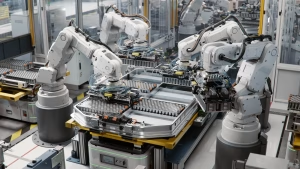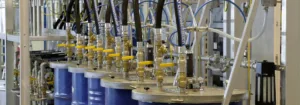Updated: November 4, 2024
ATEX, short for “Atmosphères Explosibles,” refers to the European Union directives that regulate equipment used in potentially explosive atmospheres.
These standards ensure that machinery and protective systems can operate safely in environments containing flammable gases, vapors, or combustible dusts.
For companies operating in hazardous conditions, understanding where ATEX certification is required—and choosing ATEX-certified motors like those from Atlas Copco—is essential for compliance, efficiency, and worker safety.
What Is ATEX and Why It’s Important
The ATEX Directive 2014/34/EU defines the safety requirements for electrical and mechanical equipment intended for use in explosive atmospheres.
It ensures that all components—such as motors, tools, and pumps—are designed to prevent ignition sources, such as sparks or high surface temperatures.
Complying with ATEX regulations:
Protects workers in hazardous areas
Reduces explosion risk and downtime
Meets mandatory EU safety requirements
Demonstrates commitment to safe, sustainable operations
Industries That Require ATEX Compliance
ATEX certification applies across multiple sectors where explosive atmospheres can occur. Here are the main industries where ATEX compliance is mandatory:
🔹 Oil and Gas
Offshore and onshore production
Refineries and petrochemical plants
Gas storage and transfer systems
🔹 Chemical and Pharmaceutical
Chemical processing and mixing
Pharmaceutical formulation and packaging
Solvent storage and handling
🔹 Food and Beverage Processing
Flour mills, grain silos, sugar refineries
Powder handling and spray drying
Breweries and distilleries
🔹 Mining and Mineral Extraction
Coal mines and material handling areas
Dust control and ventilation systems
🔹 Power Generation and Waste Management
Coal, biomass, and gas-fired power plants
Waste treatment and recycling facilities
In all these industries, ATEX-certified motors play a crucial role in powering production equipment safely within explosive zones.
ATEX Zone Classifications Explained
ATEX divides hazardous areas into zones based on how frequently and for how long an explosive atmosphere may exist.
| Zone | Description | Typical Example |
|---|---|---|
| Zone 0 | Explosive atmosphere present continuously or long-term | Inside fuel or solvent tanks |
| Zone 1 | Explosive atmosphere likely to occur occasionally | Around pumps, valves, mixers |
| Zone 2 | Explosive atmosphere unlikely but possible for short periods | Ventilation ducts or storage areas |
For dust (solids like flour or coal), the equivalent zones are Zone 20, 21, and 22.
Each zone determines which type of ATEX-certified motor or equipment can be safely installed.
ATEX Compliance: Key Requirements for Businesses
To comply with the ATEX Directive, companies must follow specific safety and documentation procedures:
Risk Assessment
Identify potential explosive atmospheres and classify each area into the correct ATEX zone.Certified Equipment Selection
Use ATEX-certified motors and tools, such as Atlas Copco air motors, that match the required zone classification.Installation and Maintenance
Follow manufacturer guidelines for installation and perform regular maintenance checks.Employee Training
Train all personnel on ATEX awareness, safe operation, and emergency procedures.Documentation and Records
Maintain risk assessments, inspection reports, maintenance logs, and training records to demonstrate compliance.
Why Choose Atlas Copco ATEX Motors
When working in explosive environments, Atlas Copco ATEX-certified air motors provide a robust, safe, and efficient alternative to electric motors.
✅ Key Benefits of Atlas Copco ATEX Motors:
Spark-free operation – Ideal for environments where ignition must be prevented.
Compact and durable design – Built to withstand demanding industrial conditions.
Zone-certified – Suitable for ATEX Zones 1 and 2, and for both gas and dust environments.
Variable speed and torque control – Optimizes performance and energy use.
Maintenance-friendly – Simple, reliable operation reduces downtime.
🔧 Typical Applications
Mixing and stirring in chemical plants
Conveyor systems in food processing
Valve and actuator drives in oil refineries
Drum handling and packaging in pharmaceuticals
By integrating Atlas Copco’s ATEX air motors, companies can maintain productivity while ensuring full compliance with EU safety standards.
ATEX vs. IECEx: What’s the Difference?
While ATEX is the standard in the European Union, IECEx is the international equivalent used globally.
Atlas Copco offers both ATEX and IECEx-certified air motors, giving you flexibility to operate across multiple regions while meeting the highest safety requirements.
Where Is ATEX Required FAQ
ATEX stands for “Atmosphères Explosibles”, the French term meaning “explosive atmospheres.” It refers to EU directives regulating equipment used in such conditions.
Yes. Any equipment used in explosive atmospheres within the EU must comply with ATEX Directive 2014/34/EU.
These zones classify how frequently an explosive atmosphere occurs — Zone 0 being continuous, Zone 1 occasional, and Zone 2 rare or short-term.
Atlas Copco air motors are designed to operate safely without electrical sparks or overheating, offering reliable performance in hazardous environments.
Yes. Atlas Copco also provides IECEx-certified models, recognized globally for use in similar hazardous area classifications.
Further Read
- ATEX Certification for Industrial Motors | Standards, Zones & Compliance
- Where ATEX Is Required | Industrial Motors ATEX Motors Guide
- The impact of counterfeit ATEX-certified electric motors on industry.
- Exploring the Origins of Ex Standards – The ATEX Directive
- Air Motors for Chemical and Pharmaceutical Industries
- Air Motors in Chemical and Pharmaceutical Applications
- What Are ATEX Areas? | Industrial Motors Guide
Conclusion
ATEX compliance ensures safety and reliability in any industry where explosive atmospheres are present.
By choosing Atlas Copco ATEX-certified air motors, companies can operate with confidence, knowing their equipment meets the strictest safety and performance standards.
Want to find the right ATEX motor for your application?
Contact our experts to learn how Atlas Copco ATEX air motors can improve safety, efficiency, and compliance in your operation.


